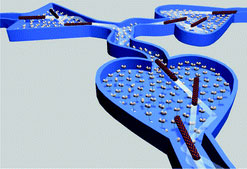| Posted: Sep 20, 2006 | |
The promise of biomolecular motors |
|
| (Nanowerk Spotlight) In the field of Nanotechnology, where inherent risks are the subject of hot debate, developments within the nascent science of biomolecular motors is hailed by scientists to be relatively benign to humans and possibly beneficial to the environment (even for applications within the military). | |
| Biomolecular motors are currently an area of fundamental research, with working applications years in the future. Biological organisms on the micro and nano scales have always used the mechanism of converting ATP (Adenosine Tri-Phosphate – the universal fuel molecule that powers all cells) into mechanical energy. Therefore an existence proof that this concept could fare very well has existed for millennia. Today's question is: "how to manufacture engineering devices powered by ATP?" | |
| Future Applications | |
| Biomolecular motors are nano sized constructs, which convert chemical energy (ATP) into mechanical work. Possible future applications for this technology include sorting, sensing, energy harvesting, molecular assembly and actuating devices. | |
| "Another application," explained Dr. Anantha Krishnan (Director of Research and Development, Lawrence Livermore National Laboratory), "is in vitro devices that would perform functions like sensing (monitoring the status of biological systems) and localized drug delivery." | |
| Military Developments | |
| Henry Hess (Assistant Professor, Department of Materials Science and Engineering, University of Florida) is funded by DARPA to pursue the development of biomolecular motors for military use. Dr. Hess is currently collaborating with Dr. George Bachand (Sandia National Laboratories) on the development of a biosensor powered by biomolecular motors. This small, disposable biosensor is designed for remote distribution over battlefields in the form of a smartdust. | |
| The plan is to fill biodegradable pieces of plastic (the size of a grain of sand) with manufactured protein motors. Depending on the analytes collected, the modules change color, which is detectable by LIDAR. The current alternative is to utilize genetically modified bacteria. The advantage of using motor proteins is that they have lost their ability to replicate. They are not organisms that have the ability to evolve or mutate. | |
 |
|
| Microtubules moving on a kinesin motor carpet through a microfabricated pattern. (© RSC Publishing) | |
| The biomolecular motors used by Dr. Hess and Dr. Bachand come from Kinesin, an extract of the fungus Thermomyces. The motor consists of two feet and a tail. The feet bind to a microtubule consuming ATP fuel. Typically the microtubule is stationary within a cell and the motors walk along the microtubule and the tail binds to various types of cargo. "In our devices," said Hess, "the tail is on a surface, which makes the motor stationary. The feet of the motor, which are standing up, move the microtubule. We then functionalize the microtubules to the antibodies or a linker to the specific cargo that we want to capture and move." | |
| Risk Factors? | |
| "It is very hard to see biomolecular motors being harmful to the environment or to humans," said Jung-Chi Liao (Research Associate, Stanford Bioengineering). "The research into biomolecular motors is in the beginning stages and the current risks are minimal. Today's research in constructing novel biomolecular motors involves techniques such as the use of genetic mutation or hybridization with nanofabricated materials. Genetic mutation happens all of the time in our bodies." | |
| "One possible future application," added Liao, "if the motors could be made more efficient, would be to implement these motors into systems that convert light energy to other forms of energy." | |
| "One of the appeals of our project," said Dr. Hess, "is that it reduces environmental risks. Our modules replace a biological organism (bacteria) and it also replaces larger battery powered devices. Environmentally our motors are benign." | |
| Currently Hess' motors are not toxic to humans. In the future toxicity will depend on developments such as the use of quantum nanodots. "Our modules are enclosed in a plastic housing and they are not being injected into human beings. The modules are small but not so small that you could easily inhale them. The key nano element in our research is proteins and protein assemblies, which are not toxic in any way," explained Hess. | |
| "Using biological motors and ATP is not a risk," continued Dr. Krishnan. "Human bodies contain both. Issues arise when implementing other materials (silicon, carbon nanotubes, polymers or quantum dots). The risk is how biological systems will respond to these materials. Studies need to be done, but we are still so early in our research efforts, that these issues have not yet been addressed." | |
| Dr. Krishnan concluded by saying that he expects to see some very interesting and novel devices based on biomolecular motors within the next five years and possibly some animal experimentation. "Human trials," he said, "will be closer to the ten-year mark." | |
| By Brian Noer, Copyright Nanowerk LLC | |
|
Become a Spotlight guest author! Join our large and growing group of guest contributors. Have you just published a scientific paper or have other exciting developments to share with the nanotechnology community? Here is how to publish on nanowerk.com. |
|
